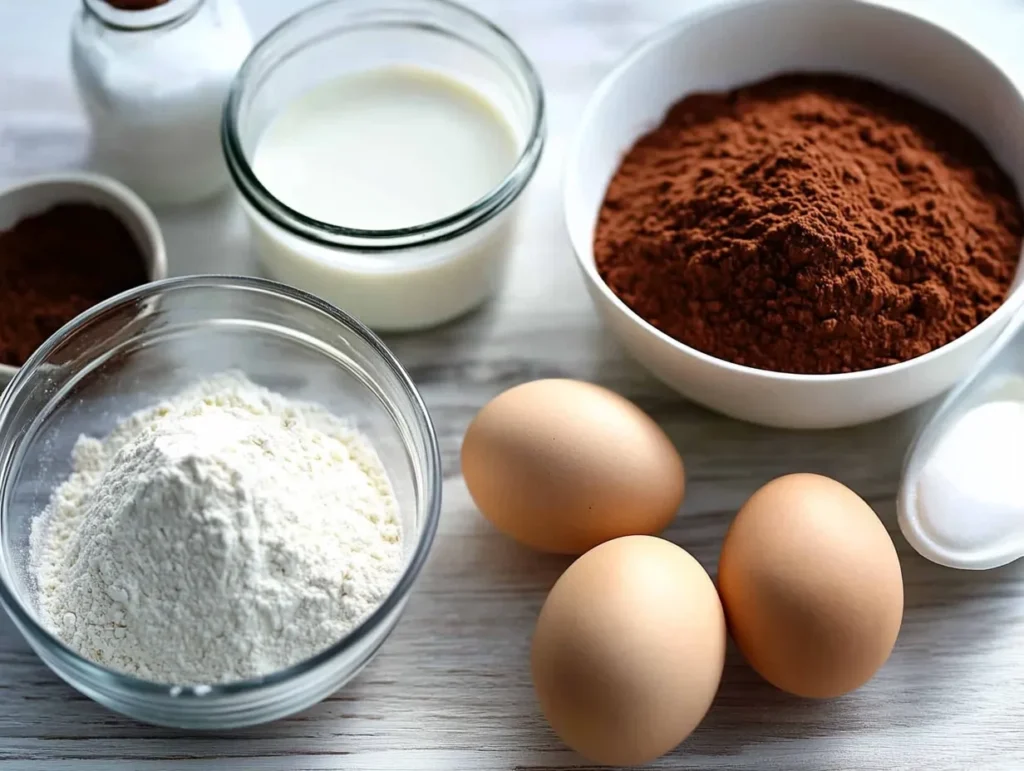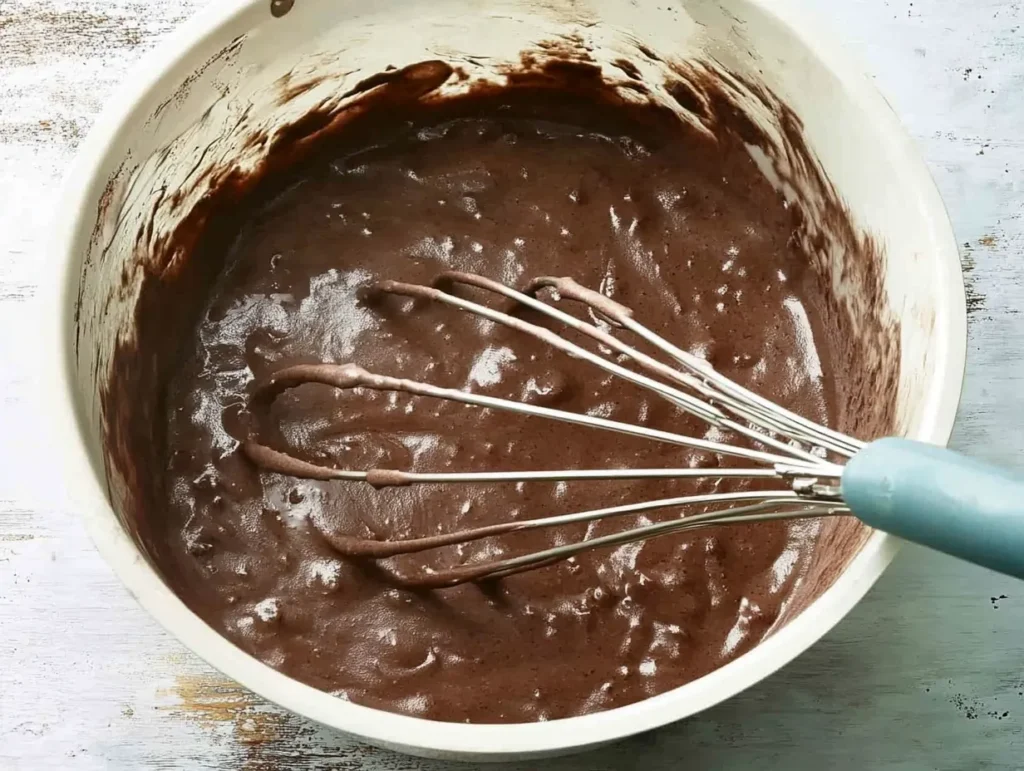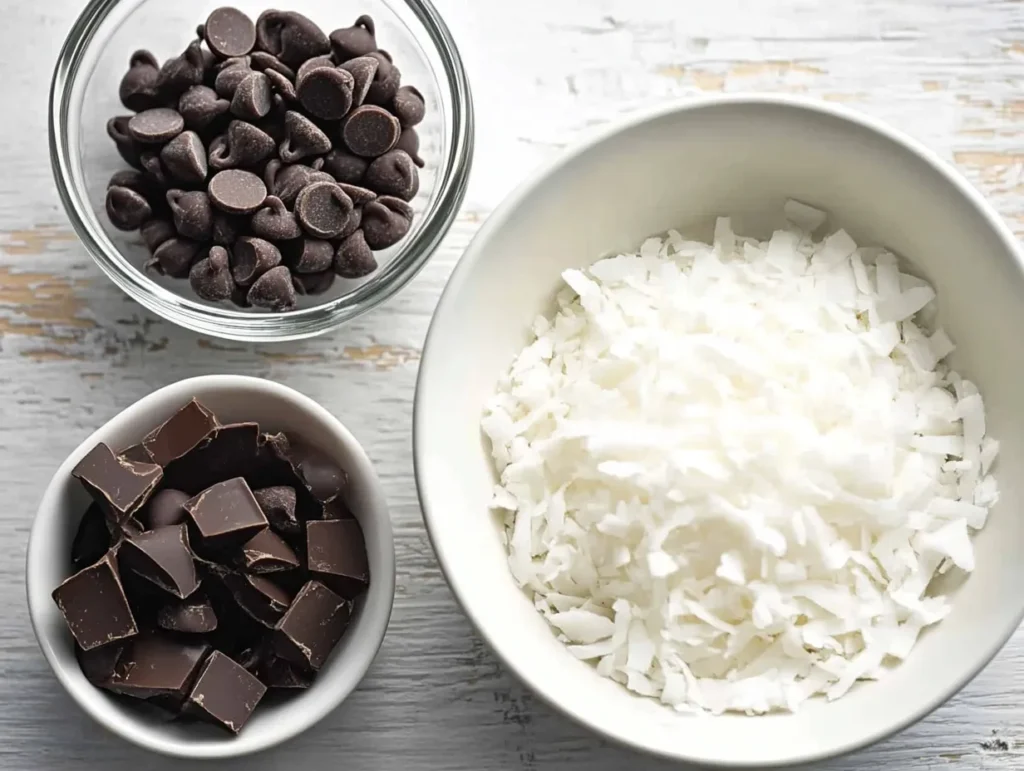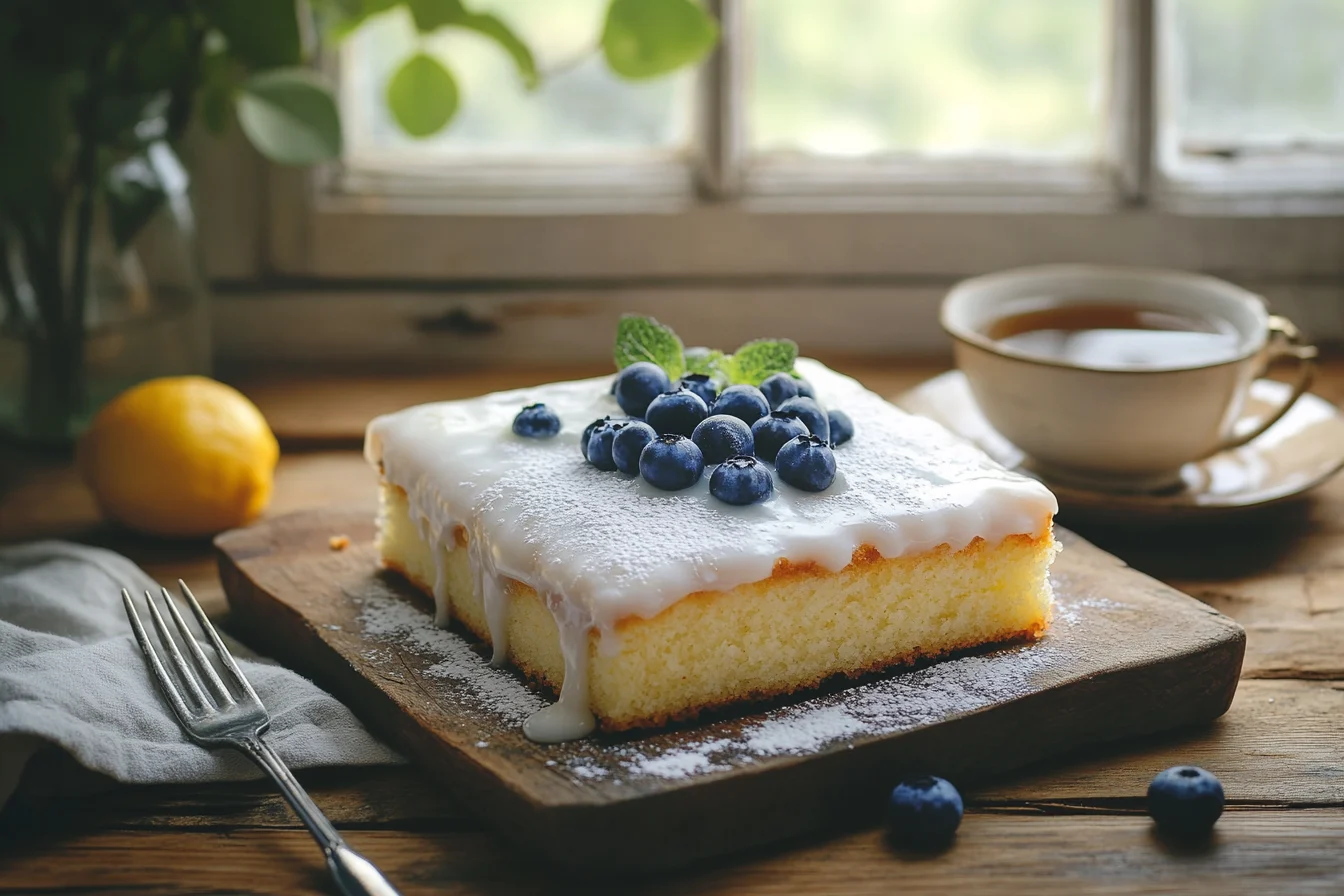Kefir sheet cake is a luscious and moist dessert that brings a tangy twist to traditional baking. This cake stands out for its rich texture, subtle tanginess, and the added nutritional benefits of kefir. Whether you’re a seasoned baker or a newcomer to this versatile dairy ingredient, kefir sheet cake promises to be a delightful addition to your recipe repertoire.
Why Kefir Is a Game-Changer in Baking
Kefir, a fermented dairy product, is renowned for its probiotic benefits and versatility in the kitchen. Its creamy consistency and slightly sour taste make it a fantastic substitute for ingredients like buttermilk or yogurt. In baking, kefir adds moisture and enhances the flavor profile of cakes, making them incredibly soft and tender. Moreover, its acidity interacts with baking soda, contributing to an excellent rise and a fluffy texture.
Overview of Texture and Flavor
Kefir sheet cake boasts a perfect balance of moistness and lightness. The tangy undertones of kefir complement the sweetness of the cake, creating a complex yet harmonious flavor. The result is a dessert that feels indulgent yet refreshing, ideal for any occasion.

The Origins of Kefir in Baking
History of Kefir as a Dairy Product
Kefir originated in the Caucasus Mountains, where it has been a staple of the local diet for centuries. Traditionally made by fermenting milk with kefir grains, this nutrient-rich drink became widely recognized for its health benefits and unique flavor. Its journey from a regional specialty to a global phenomenon has brought kefir into the spotlight as a culinary ingredient.
How Kefir Became a Popular Ingredient in Baking
As its popularity spread, bakers discovered that kefir’s tangy profile and natural acidity could elevate traditional recipes. By replacing buttermilk or sour cream, kefir not only enhanced the taste of baked goods but also added a probiotic punch. Today, it is a favorite among health-conscious bakers looking to create desserts that are both delicious and nutritious.
Cultural Influences on Kefir Desserts
Different cultures have embraced kefir in their own unique ways. In Eastern Europe, kefir is often used in pancakes and breads, while Middle Eastern cuisines incorporate it into savory pastries. In modern baking, its versatility has inspired recipes like kefir cakes, muffins, and cookies, each reflecting a fusion of tradition and innovation.
By understanding the rich history and versatility of kefir, bakers can fully appreciate its transformative impact on desserts like the kefir sheet cake. This tangy delight is not just a dessert but a testament to the cultural and culinary evolution of a timeless ingredient.Key Ingredients in Kefir Sheet Cake
Importance of Kefir in the Recipe
Kefir is the star ingredient in this sheet cake, bringing both flavor and functionality to the recipe. Its natural acidity helps activate the baking soda, leading to a fluffy and tender crumb. Additionally, kefir’s tangy flavor balances the sweetness of the cake, creating a well-rounded taste.
Flour Options for Different Textures
The type of flour you choose can significantly affect the texture of your cake. All-purpose flour works well for a classic, soft texture, while cake flour results in a lighter, more delicate crumb. For a heartier option, whole wheat flour can add a nutty depth, although it may make the cake slightly denser.
Role of Eggs, Sugar, and Butter
Eggs provide structure and richness, ensuring the cake holds its shape while remaining moist. Sugar sweetens the cake and contributes to a golden-brown finish during baking. Butter, on the other hand, adds flavor and tenderness, making each bite melt in your mouth. Together, these ingredients create a harmonious base for the tangy kefir to shine.
Benefits of Using Kefir in Baking
Moisture and Texture Improvements
Kefir’s creamy consistency adds moisture to the batter, resulting in a cake that stays soft and fresh for days. Its acidity also interacts with baking agents to create a lighter texture, making the cake less dense and more airy.
Tangy Flavor Enhancement
The slight tanginess of kefir adds a unique depth to the flavor of the cake. This tang perfectly complements the sweetness, making the cake taste rich yet balanced. It’s an ideal choice for those who enjoy a hint of tartness in their desserts.
Health Benefits of Probiotics in Kefir
Beyond its culinary advantages, kefir is packed with probiotics that promote gut health. Incorporating kefir into baking allows you to enjoy these benefits without sacrificing flavor. Additionally, kefir contains essential nutrients like calcium and protein, making your dessert a slightly healthier indulgence.
Step-by-Step Recipe for Kefir Sheet Cake
Ingredients List (With Improved Transition Words)
Here is the complete list of ingredients you will need to make a delicious kefir sheet cake. Additionally, substitutions and adjustments are included for customization.
- 2 cups all-purpose flour: Alternatively, you can use cake flour for a lighter texture.
- 1 teaspoon baking soda: This works with kefir to give the cake a perfect rise.
- 1/2 teaspoon salt: To balance and enhance the overall flavor.
- 1 cup kefir: You may use plain kefir for a classic taste, or choose a flavored version to add a unique twist.
- 1/2 cup unsalted butter: Melted and cooled; this ensures the cake stays moist and rich.
- 1 cup granulated sugar: Necessary for sweetness, though you can adjust based on preference.
- 2 large eggs: These provide structure and richness to the batter.
- 1 teaspoon vanilla extract: This enhances the flavor profile and adds a sweet aroma.

Using these carefully selected ingredients, you’ll create a tangy, moist, and flavorful kefir sheet cake that is sure to impress.
Detailed Preparation Steps
- Preheat the Oven: Set your oven to 350°F (175°C) and grease a 9×13-inch sheet pan or line it with parchment paper.
- Prepare the Dry Ingredients: In a bowl, whisk together the flour, baking soda, and salt. Set aside.
- Mix Wet Ingredients: In a separate bowl, beat the sugar and eggs until light and fluffy. Gradually add the melted butter, followed by the kefir and vanilla extract.
- Combine and Mix: Slowly fold the dry ingredients into the wet mixture, stirring just until combined. Avoid overmixing to ensure a tender texture.
- Pour the Batter: Transfer the batter into the prepared sheet pan, spreading it evenly with a spatula.
- Bake: Bake for 25–30 minutes, or until a toothpick inserted into the center comes out clean.

Baking Tips for Perfect Results
- Use room-temperature ingredients for smoother mixing and even baking.
- Avoid overmixing the batter to prevent a dense cake.
- Let the cake cool completely before frosting or serving to allow the flavors to set.
With its tangy flavor, moist texture, and probiotic boost, this kefir sheet cake is as delightful as it is easy to make. Perfect for any occasion, it’s a must-try recipe for bakers of all levels!Variations and Additions
Adding Fruits Like Berries or Citrus Zest
Enhance your kefir sheet cake by incorporating fresh or dried fruits. Blueberries, raspberries, or chopped strawberries add bursts of flavor and juiciness. Citrus zest, such as lemon or orange, can provide a refreshing tang that complements the kefir’s natural tartness.
Using Different Frostings
The versatility of kefir sheet cake allows you to experiment with various frostings. A tangy cream cheese frosting pairs perfectly with the cake’s flavor. For a richer option, try a smooth chocolate ganache. Alternatively, a simple glaze made with powdered sugar and milk offers a light and elegant finish.
Seasonal Adaptations
Adjust your kefir sheet cake to reflect the seasons. Add warm spices like cinnamon and nutmeg during fall, or incorporate fresh, juicy peaches in summer. This flexibility makes it a dessert you can enjoy year-round.
How to Serve Kefir Sheet Cake
Best Pairings with Tea, Coffee, or Milk
Kefir sheet cake pairs beautifully with beverages. Its tangy flavor balances the robustness of black tea or coffee, while a glass of cold milk enhances its creamy texture. For a unique twist, serve it with a chai latte or herbal tea.
Presentation Tips for Parties
To make your cake party-ready, slice it into neat squares and top each piece with a dollop of whipped cream or fresh fruit. Serving it on a decorative platter adds a touch of elegance.
Storing and Reheating Leftovers
Store leftovers in an airtight container in the refrigerator for up to five days. To reheat, microwave individual slices for 10–15 seconds, or enjoy it cold as a quick snack.
Nutritional Information
Calorie Breakdown
A typical slice of kefir sheet cake contains approximately 250–300 calories, depending on the ingredients and frosting. Using low-fat kefir or reducing sugar can help lower the calorie count.
Key Nutrients and Probiotics
Kefir adds a probiotic boost to the cake, promoting gut health. Additionally, it provides calcium, protein, and essential vitamins like B12. These nutrients make it a dessert with hidden health benefits.
Tips for Making a Healthier Version
For a lighter cake, substitute whole wheat flour for part of the all-purpose flour, use natural sweeteners like honey or maple syrup, and opt for low-fat kefir. Reducing butter and replacing it with applesauce is another great way to cut calories without sacrificing moisture.
Common Mistakes and How to Avoid Them
Overmixing the Batter
Overmixing can lead to a dense cake. To avoid this, mix just until the ingredients are combined, and use a gentle folding motion.
Baking Time and Temperature Issues
Baking the cake at the wrong temperature or for too long can result in a dry texture. Always preheat your oven and use an oven thermometer to ensure accuracy. Start checking for doneness a few minutes before the recommended baking time.
Choosing the Wrong Kefir Consistency
Using kefir that is too thin or too thick can affect the batter’s texture. Opt for plain, unsweetened kefir with a consistency similar to buttermilk for the best results.
Frequently Asked Questions (FAQs)
What Is Kefir, and Where Can I Buy It?
You can find it in the dairy section of most grocery stores or specialty health food stores.
Can I Substitute Kefir with Yogurt?
Yes, plain yogurt can be used as a substitute for kefir. To mimic kefir’s tanginess, thin the yogurt with a little water or milk.
How Long Does the Cake Stay Fresh?
When stored properly in an airtight container, kefir sheet cake stays fresh for up to five days in the refrigerator.
Is It Gluten-Free?
Traditional kefir sheet cake uses all-purpose flour, which contains gluten. However, you can make it gluten-free by using a gluten-free flour blend.
Can I Make a Vegan Version?
Absolutely! Replace kefir with a plant-based alternative like coconut or almond milk yogurt. Substitute eggs with flaxseed meal or applesauce, and use vegan butter or oil.
By addressing these common questions and potential pitfalls, you’ll master the art of baking a delicious kefir sheet cake that’s perfect for any occasion.Creative Frosting Ideas
Lemon Glaze
A simple lemon glaze can elevate the tangy flavors of kefir sheet cake. Combine powdered sugar with freshly squeezed lemon juice and drizzle it over the cooled cake. This light and zesty frosting is perfect for spring and summer gatherings.
Vanilla Cream Cheese Frosting
For a rich and creamy option, whip up a vanilla cream cheese frosting. The tanginess of the cream cheese pairs beautifully with the cake’s flavor, while the vanilla adds a hint of sweetness. Spread it generously over the cake for an indulgent finish.
Chocolate Ganache
A decadent chocolate ganache is ideal for chocolate lovers. Melt dark or milk chocolate with heavy cream, then pour it over the cake. The glossy finish and rich flavor provide a luxurious touch that makes the dessert feel extra special.
Storing and Freezing Kefir Sheet Cake
Best Practices for Refrigeration
To keep your cake fresh, store it in an airtight container or cover it tightly with plastic wrap. Refrigerate for up to five days to maintain its moisture and flavor.
How to Freeze for Long-Term Storage
For longer storage, wrap the cake tightly in plastic wrap and place it in a freezer-safe bag. It can be frozen for up to three months. To avoid freezer burn, ensure no air is trapped in the wrapping.
Reheating Instructions
When ready to enjoy, thaw the cake in the refrigerator overnight. For a warm slice, microwave individual pieces for 10–15 seconds or reheat in an oven at 300°F (150°C) for a few minutes.
Comparing Kefir Sheet Cake to Other Desserts
How It Differs from Traditional Sheet Cakes
Kefir sheet cake stands out for its tangy flavor and moist texture, which set it apart from traditional sheet cakes that often rely on milk or cream. The use of kefir adds complexity and depth to the taste.
Advantages Over Sour Cream-Based Cakes
While sour cream cakes are also moist and rich, kefir provides a lighter texture and a unique probiotic boost. Its acidity interacts better with leavening agents, ensuring a fluffier crumb.
Why It’s a Unique Dessert
The combination of kefir’s tangy flavor, nutritional benefits, and versatility makes this cake one-of-a-kind. It’s a dessert that blends tradition with innovation, appealing to both health-conscious and flavor-loving bakers.
Reader Reviews and Feedback
Testimonials from Home Bakers
Many home bakers praise kefir sheet cake for its moist texture and balanced flavor. One reviewer noted, “It’s the perfect blend of tangy and sweet—everyone at the party asked for the recipe!”
Common Praises and Critiques
Fans often highlight the cake’s simplicity and ease of preparation. However, some suggest experimenting with different frostings to customize the flavor. A common critique is that the cake can be too tangy for those unaccustomed to kefir, but a sweeter frosting typically balances this.
Inspiring Stories of Family Traditions
Several readers share how kefir sheet cake has become a family favorite. One baker mentioned, “This cake reminds me of my grandmother’s baking—she always used kefir in her recipes. Now it’s a tradition in my own family.”
Kefir Sheet Cake: A Tangy Delight
Kefir sheet cake is a deliciously moist dessert that brings a unique tangy flavor to traditional baking. Whether you are a seasoned baker or trying kefir for the first time, this recipe combines simplicity with rich flavors, making it perfect for all occasions.
The Role of Kefir in Baking
Kefir, a fermented dairy product, is prized for its acidity and probiotics. Its tangy taste complements sweet desserts, while its creamy texture ensures cakes stay moist and tender. To learn more about baking with kefir, check out Kefir Baking Recipe.

Key Ingredients for Kefir Sheet Cake
This cake requires simple ingredients, many of which are pantry staples:
- Kefir: The star of the recipe, lending tanginess and moisture.
- Flour: All-purpose flour works best, but whole wheat flour adds a nutty depth.
- Eggs: For structure and richness.
- Butter or Oil: Adds moisture and flavor.
- Sugar: Sweetens and balances the tanginess of kefir.
For a recipe card with step-by-step instructions, visit Kefir Sheet Cake Recipe Card.
Creative Variations and Frostings
Adding Fruits and Zests
Enhance your cake with fresh fruits like blueberries or citrus zest for a refreshing twist.
Frosting Ideas
- Lemon Glaze: Brightens the cake’s tangy flavor.
- Vanilla Cream Cheese Frosting: Adds richness.
- Chocolate Ganache: Creates a decadent finish.
For a unique spin, try the Chocolate Chai Kefir Cake recipe.
Storing and Freezing
- Refrigeration: Store in an airtight container for up to five days.
- Freezing: Wrap the cake tightly and freeze for up to three months. Thaw overnight in the fridge before serving.

Comparing Kefir Sheet Cake to Other Desserts
Unlike sour cream-based cakes, kefir sheet cake has a lighter texture and a distinct tangy profile. For a deeper dive into similar desserts, explore Czech Dessert Recipes.
Conclusion: The Joy of Baking with Kefir
Kefir sheet cake is more than just a dessert—it’s a celebration of flavor, texture, and tradition. Its unique tanginess and moistness make it a standout choice for any occasion, from casual family dinners to festive celebrations.
Whether you’re a seasoned baker or a newcomer to kefir, this cake deserves a spot on your table. Don’t hesitate to experiment with different variations and frostings to make it your own. Embrace the joy of baking with kefir and enjoy a dessert that’s as delicious as it is unique.

